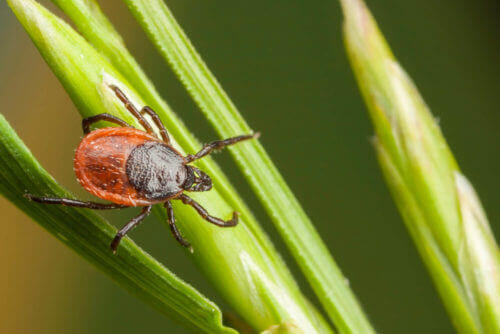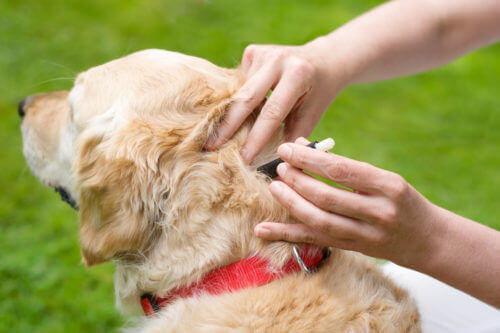Black Legged (Deer) Tick Facts & Information
Everything you need to know about deer ticks
What Does a Black-Legged (Deer) Tick Look Like

When unengorged (i.e. not filled with blood), the female blacklegged tick is roughly 1/8”, while male ticks are slightly smaller at about 1/16”. Both male and female deer ticks have flat, oval bodies, and are not hard-shelled. Female deer ticks are orangish brown in color except for their legs, mouthparts, and scutum (shield). Unengorged, their abdomen is a dark reddish-brown color but becomes darker after feeding on a host. Male deer ticks are reddish brown overall.
The blacklegged tick is longer than wide, and its sharply pointed toothed mouthparts are clearly visible from above. Newly hatched unengorged larvae are about 1/32” long and have 6 legs. Unengorged nymphs (baby ticks) are about 1/16” long and have 8 legs.
Not the tick you have?
The blacklegged tick is longer than wide, and its sharply pointed toothed mouthparts are clearly visible from above. Newly hatched unengorged larvae are about 1/32” long and have 6 legs. Unengorged nymphs (baby ticks) are about 1/16” long and have 8 legs.
Not the tick you have?
where are deer ticks found
The most common sign of a blacklegged tick problem is spotting one in your yard, on your body, or on your pet or child. Blacklegged ticks prefer to hide in grass and shrubs while waiting for a passing host, so be sure to keep your yard well maintained and mowed. They prefer vegetation located in transitional areas such as where forest meets field, mowed lawn meets unmowed fence line, or a foot trail through high grass or forest as these areas are where most animals travel sometime during each 24-hour period.
The other habitat most likely to harbor blacklegged ticks is the den, nest, or nesting area of its host such as that of skunks, raccoons, opossums, but especially the white-footed mouse. The white-footed mouse prefers woody or brushy areas. It nests in any place that gives shelter such as below ground, in stumps, logs, old bird or squirrel nests, woodpiles, buildings, etc. These mice can bring ticks in with them if they enter your home.
The other habitat most likely to harbor blacklegged ticks is the den, nest, or nesting area of its host such as that of skunks, raccoons, opossums, but especially the white-footed mouse. The white-footed mouse prefers woody or brushy areas. It nests in any place that gives shelter such as below ground, in stumps, logs, old bird or squirrel nests, woodpiles, buildings, etc. These mice can bring ticks in with them if they enter your home.

During the winter, adult ticks feed primarily on the blood of white-tailed deer. In the spring, a female tick will drop off its host and will deposit about 3,000 eggs. Nymphs, or baby ticks, feed on mice, squirrels, raccoons, skunks, dogs, humans and birds.
A favorite feeding area for these ticks on humans is at the back of the neck, at the base of the skull; long hair makes detection more difficult. However, the ticks will usually crawl about for up to 4 hours or so before they attach. Then, a tick has to be attached for a period of 6-8 hours before a successful transmission can take place.
A favorite feeding area for these ticks on humans is at the back of the neck, at the base of the skull; long hair makes detection more difficult. However, the ticks will usually crawl about for up to 4 hours or so before they attach. Then, a tick has to be attached for a period of 6-8 hours before a successful transmission can take place.
what Problems do deer ticks cause
Black-legged ticks, more commonly known as deer ticks, are the only known vector for Lyme disease. The blacklegged (deer) tick is a notorious biting arachnid named for its dark legs. Blacklegged ticks are sometimes called deer ticks because their preferred adult host is the white-tailed deer. Deer ticks are found primarily in the northeastern, mid-Atlantic states including New Jersey, New York, Connecticut, Delaware, and Pennsylvania. This tick is of medical importance because in addition to its ability to transmit Lyme disease, it can also transmit anaplasmosis, human babesiosis, Powassan encephalitis, and more. The deer tick nymphs will latch onto people, dogs, birds, and larger wild mammals like raccoons, opossums, squirrels, and skunks. While they may seem more prominent from April to August, every life stage of a tick is able to survive through the winter months. That makes it all the more important to have tick removal services done to provide tick control around your home or business.
how can i prevent deer ticks
In order to avoid being bitten by a deer tick, apply an insect repellent containing an EPA-registered ingredient, such as DEET, picaridin, or oil of lemon eucalyptus. Also, consider wearing long sleeved shirts and pants, preferably light colored so ticks will be easy to detect, and tuck your pants into your socks. This may not be a practical solution during the hot and humid Connecticut, New York, New Jersey, Pennsylvania, and Delaware summers, though! The best thing you can do is inspect clothing and skin on pets and all people after being outside. Immediately wash any clothes worn outside.
If you have a bite from a deer tick or find one on you, use fine-tipped tweezers to grasp it as close to the skin’s surface as possible. Pull upward with steady, even pressure. Don’t twist or jerk the tick as this can cause the mouthparts to break off and remain in the skin. Once the tick is removed, thoroughly clean the bite site with soap and water. Save the tick in a plastic bag and bring it to the doctor with you. Be sure to see a doctor as soon as you so you can start treatments for Lyme disease if needed.
If you have a bite from a deer tick or find one on you, use fine-tipped tweezers to grasp it as close to the skin’s surface as possible. Pull upward with steady, even pressure. Don’t twist or jerk the tick as this can cause the mouthparts to break off and remain in the skin. Once the tick is removed, thoroughly clean the bite site with soap and water. Save the tick in a plastic bag and bring it to the doctor with you. Be sure to see a doctor as soon as you so you can start treatments for Lyme disease if needed.
Why Western for deer tick control
We’re passionate about controlling ticks around your home because we live and work here – it’s our neighborhood, too. With our almost 100 years of experience keeping homes and businesses in Connecticut, Delaware, New Jersey, New York, and Pennsylvania safe from pests, Western has the experience you can trust.
100% Satisfaction Guarantee
24-Hour Guaranteed Response
Board Certified Entomologists
Say goodbye to black-legged (deer) ticks.
GET MY QUOTE
